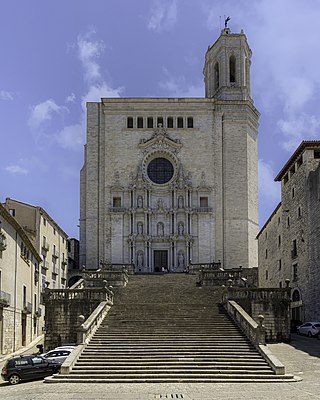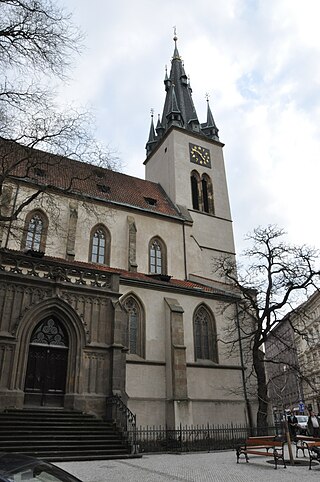
Cathedrals, collegiate churches, and monastic churches like those of abbeys and priories, often have certain complex structural forms that are found less often in parish churches. They also tend to display a higher level of contemporary architectural style and the work of accomplished craftsmen, and occupy a status both ecclesiastical and social that an ordinary parish church rarely has. Such churches are generally among the finest buildings locally and a source of regional pride. Many are among the world's most renowned works of architecture. These include St Peter's Basilica, Notre-Dame de Paris, Cologne Cathedral, Salisbury Cathedral, Antwerp Cathedral, Prague Cathedral, Lincoln Cathedral, the Basilica of Saint-Denis, Santa Maria Maggiore, the Basilica of San Vitale, St Mark's Basilica, Westminster Abbey, Saint Basil's Cathedral, Antoni Gaudí's incomplete Sagrada Família and the ancient cathedral of Hagia Sophia in Istanbul, now a mosque.

Korčula is a Croatian island in the Adriatic Sea. It has an area of 279 km2 (108 sq mi), is 46.8 km (29.1 mi) long and on average 7.8 km (4.8 mi) wide, and lies just off the Dalmatian coast. Its 15,522 inhabitants (2011) make it the second most populous Adriatic island after Krk. The population are almost entirely ethnic Croats (95.74%). The island is twinned with Rothesay in Scotland. It is known for Grk, a white wine that is only produced here and not exported due to limited production.

Tourism in Croatia is a major industry of country's economy, accounting for almost 20% of Croatia's gross domestic product (GDP) as of 2021.

Hvar is a Croatian island in the Adriatic Sea, located off the Dalmatian coast, lying between the islands of Brač, Vis and Korčula. Approximately 68 kilometres (42.25 mi) long, with a high east–west ridge of Mesozoic limestone and dolomite, the island of Hvar is unusual in the area for having a large fertile coastal plain, and fresh water springs. Its hillsides are covered in pine forests, with vineyards, olive groves, fruit orchards and lavender fields in the agricultural areas. The climate is characterized by mild winters, and warm summers with many hours of sunshine. The island has 10,678 residents according to the 2021 census, making it the 4th most populated of the Croatian islands.
Stari Grad is a town on the northern side of the island of Hvar in Dalmatia, Croatia. One of the oldest towns in Europe, its position at the end of a long, protected bay and next to prime agricultural land has long made it attractive for human settlement. Stari Grad is also a municipality within the Split-Dalmatia County.

Hvar is a town and port on the island of Hvar, part of Split-Dalmatia County, Croatia. The municipality has a population of 4,251 (2011) while the town itself is inhabited by 3,771 people, making it the largest settlement on the island of Hvar. It is situated on a bay in the south coast of the island, opposite from the other nearby towns of Stari Grad and Jelsa.

Girona Cathedral, also known as the Cathedral of Saint Mary of Girona, is a Roman Catholic church located in Girona, Catalonia, Spain. It is the seat of the Roman Catholic Diocese of Girona. The cathedral's interior includes the widest Gothic nave in the world, with a width of 23 metres (75 ft), and the second-widest of any church after that of St. Peter's Basilica. Its construction was begun in the 11th century in the Romanesque architectural style, and continued in the 13th century in the Gothic style. Of the original Romanesque edifice only the 12th-century cloister and a bell tower remain. The second bell tower was completed in the 18th century.

Vrboska is a settlement on the north coast of the island of Hvar in Dalmatia, Croatia, in the Municipality of Jelsa. Founded in the 15th century as a fishing harbour, the town's fortress Church of Sv. Marija was built as a refuge for its inhabitants during the 16th century. Vrboska has a population of 548 at the 2011 census.

The Cathedral of St. Anastasia is the Roman Catholic cathedral of Zadar, Croatia, seat of the Archdiocese of Zadar, and the largest church in all of Dalmatia.
The architecture of Montenegro is a mixture of many influences, from Roman and Venetian to Ottoman and modern times.

Padua Cathedral, or Basilica Cathedral of Saint Mary of the Assumption, is a Catholic church and minor basilica located on the east end of Piazza Duomo, adjacent to the bishop's palace in Padua, Veneto, Italy.

Korčula is a town on the east coast of the island of Korčula, in Croatia, in the Adriatic.

Tvrdalj Castle is a castle in Stari Grad, on the island of Hvar, Croatia.

The Cathedral of St. Stephen in Hvar is a Roman Catholic cathedral in the city of Hvar, on the island of Hvar in Split-Dalmatia County, Croatia.

The Basilica di San Pietro di Castello, commonly called San Pietro di Castello, is a Roman Catholic minor basilica of the Patriarch of Venice located in the Castello sestiere of the Italian city of Venice. The present building dates from the 16th century, but a church has stood on the site since at least the 7th century. From 1451 to 1807, it was the city's cathedral church, though hardly playing the usual dominant role of a cathedral, as it was overshadowed by the "state church" of San Marco and inconveniently located. During its history, the church has undergone a number of alterations and additions by some of Venice's most prominent architects. Andrea Palladio received his first commission in the city of Venice from the Patriarch Vincenzo Diedo to rebuild the facade and interior of St Pietro, but Diedo's death delayed the project.

The Metropolitan Cathedral of Saint Agatha, usually known as the Catania Cathedral, is a Roman Catholic cathedral in Catania, Sicily, southern Italy. It was the seat of the Bishops of Catania until 1859, when the diocese was elevated to an archdiocese, and since then has been the seat of the Archbishops of Catania.

The Pula Cathedral or fully the Cathedral of the Assumption of the Blessed Virgin Mary is a co-cathedral in Pula, Croatia. Along with the Euphrasian Basilica it is one of the two official seats of the Roman Catholic Diocese of Poreč and Pula. The church is located on the south side of the Pula bay at the foot of the hill with the 17th century Venetian fort. The site of the present-day church has been used for religious worship since ancient Roman times and the first Christian churches on the site were built in the late 4th and early 5th century AD. These had gone through a series of enlargements and reconstructions over the ages.

The Cathedral of Przemyśl, officially the Cathedral Basilica of the Assumption of the Blessed Virgin Mary and St. John the Baptistin Przemyśl, is a Latin Catholic cathedral in Przemyśl, Poland. It is the main church of the Archdiocese of Przemyśl, located at the Cathedral Square in the Old Town.

Otranto Cathedral is a Roman Catholic cathedral in the Italian city of Otranto, dedicated to the Annunciation of the Virgin Mary. It is the archiepiscopal seat of the Archdiocese of Otranto. The cathedral was consecrated in 1088. It is 54 metres long by 25 metres wide and is built on 42 monolithic granite and marble columns from unknown quarries. Its plan is a three-aisled nave with an apsidal east end. On either side of the west façade are two lancet windows.

The St. Stephen's Church is located in Štěpánská street in Prague 2, New Town. It is a church from the second half of the 14th century, which was built near the Romanesque St. Stephen rotunda. The church was dedicated to St. Stephen, traditionally regarded as the first martyr of Christianity, who was, according to the Acts of the Apostles, a deacon in the early church at Jerusalem who aroused the enmity of members of various synagogues by his teachings. And then rotunda was dedicated to St. Longin.





















